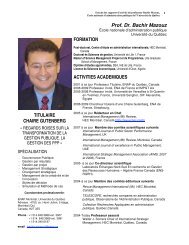Why do firms both make and buy? An investigation of concurrent ...
Why do firms both make and buy? An investigation of concurrent ...
Why do firms both make and buy? An investigation of concurrent ...
Create successful ePaper yourself
Turn your PDF publications into a flip-book with our unique Google optimized e-Paper software.
306 A. Parmigiani<br />
be a way to employ underutilized equipment or<br />
personnel for <strong>both</strong> <strong>firms</strong> <strong>and</strong> their suppliers. If<br />
<strong>both</strong> the firm <strong>and</strong> its suppliers <strong>do</strong> have sufficient<br />
expertise <strong>and</strong>/or overlap with other products,<br />
<strong>concurrent</strong> sourcing can be beneficial, particularly<br />
if the inputs are homogeneous. The choice<br />
<strong>of</strong> <strong>both</strong> making <strong>and</strong> <strong>buy</strong>ing may be more important<br />
than the precise percentage produced internally,<br />
so managers may be able to allow this<br />
percentage to fluctuate without losing the benefits<br />
<strong>of</strong> this sourcing mode. However, caution should<br />
be taken when interpreting the results <strong>of</strong> this<br />
study in terms <strong>of</strong> cost minimization. The advice<br />
above holds in the theoretical case, such that <strong>firms</strong><br />
making decisions consistent with the aforementioned<br />
predictions should enjoy lower sourcing<br />
costs; in actuality, however, difficulty in implementation,<br />
such as selecting suppliers or managing<br />
logistics, can <strong>of</strong>fset some <strong>of</strong> the potential savings.<br />
Many extensions <strong>of</strong> this research could build<br />
on its findings. This research supports David<br />
<strong>and</strong> Han’s (2004) observation that TCE <strong>do</strong>es not<br />
adequately predict between hybrid <strong>and</strong> hierarchical<br />
modes, but that multiple theories should<br />
be used. One key question that scholars could<br />
examine using TCE logic along with other theories<br />
is the determinants <strong>of</strong> the mix <strong>of</strong> internal<br />
vs. external sourcing as a second-order decision.<br />
Firms may select a percentage to produce<br />
internally as a decision variable, analogous to<br />
franchisors that may first determine to use franchising<br />
<strong>and</strong> then select the proportion <strong>of</strong> outlets<br />
to operate internally (Lafontaine <strong>and</strong> Shaw,<br />
2005). The findings <strong>of</strong> this franchising work, prior<br />
research in dual distribution (Sa Vinhas, 2002),<br />
<strong>and</strong> the current study suggest there could be<br />
different antecedents to the decisions <strong>of</strong> sourcing<br />
mode choice vs. percentage <strong>of</strong> internal production.<br />
The data in this paper left much <strong>of</strong><br />
the variation in the percentage produced internally<br />
unexplained <strong>and</strong> this percentage was evenly<br />
distributed, suggesting no clear optimal percentage.<br />
One could also investigate the performance<br />
implications <strong>of</strong> choosing <strong>concurrent</strong> sourcing. All<br />
<strong>of</strong> the organizational economics theories used in<br />
this paper assume that <strong>firms</strong> typically select the<br />
most efficient sourcing mode. If governance form<br />
matters, then we would expect misaligned sourcing<br />
transactions to have negative performance implications.<br />
But since performance is multidimensional,<br />
including price, delivery, quality, <strong>and</strong> other criteria,<br />
a sourcing mode superior in all <strong>of</strong> these areas<br />
may not exist. Furthermore, firm-specific attributes<br />
such as unionization appear to be important in<br />
the sourcing decision. The ability to manage suppliers<br />
could be investigated as <strong>firms</strong> likely have<br />
varied skills in this area, as suggested by the<br />
relational contracting literature (e.g., Dyer, 1997),<br />
but scarce research has been conducted to empirically<br />
tie these skills to measures, sourcing mode<br />
choice, <strong>and</strong> performance results. Leiblein, Reuer,<br />
<strong>and</strong> Dalsace (2002) have used multistage models to<br />
link the <strong>make</strong>-or-<strong>buy</strong> decision to subsequent performance,<br />
but extending this to incorporate three<br />
sourcing modes would be econometrically challenging<br />
as the st<strong>and</strong>ard Heckman correction could<br />
not be used, particularly if the performance variable<br />
was not continuous. Cassiman <strong>and</strong> Veugelers<br />
(2006) employed several different models for<br />
innovation performance <strong>and</strong> compared the differences<br />
in the coefficients on the sourcing dummy<br />
variables, but they were investigating the sourcing<br />
<strong>of</strong> just one activity (research <strong>and</strong> development).<br />
Gulati, Lawrence, <strong>and</strong> Puranam (2005) used<br />
a switching regression to connect sourcing modes<br />
(<strong>make</strong>, <strong>buy</strong>, or ally) with performance, but since<br />
their data originated from two <strong>firms</strong> it is not<br />
clear whether this method can be applied when<br />
many more <strong>firms</strong> <strong>and</strong> different types <strong>of</strong> goods are<br />
involved.<br />
In conclusion, two contributions emanate from<br />
this research. First, firm boundaries are best investigated<br />
using a multi-theoretic approach, as aspects<br />
<strong>of</strong> the environment, <strong>firms</strong>, <strong>and</strong> the good all affect<br />
the sourcing choice. Even small, relatively simple<br />
<strong>firms</strong> in this mature industry used at least three<br />
options, suggesting that firm boundary choices<br />
for large, multinational <strong>firms</strong> in rapidly changing<br />
industries will be considerably more complex.<br />
We can deepen our underst<strong>and</strong>ing <strong>of</strong> ‘<strong>make</strong>-or<strong>buy</strong>’<br />
decisions by also considering the <strong>concurrent</strong><br />
sourcing choice. Second, this choice <strong>do</strong>es not<br />
appear to be a simple weighted average along a<br />
<strong>make</strong>/<strong>buy</strong> continuum, but rather a distinct choice<br />
with unique advantages <strong>and</strong> disadvantages, chosen<br />
by <strong>firms</strong> when conditions warrant. Other scholars<br />
have shown that diverse types <strong>of</strong> supply arrangements<br />
within <strong>and</strong> between inputs can be complementary.<br />
This paper goes a step further <strong>and</strong> posits<br />
that internal <strong>and</strong> external sourcing can be synergistic<br />
when used <strong>concurrent</strong>ly, clarifying this simple<br />
hybrid mode <strong>of</strong> organizing.<br />
Copyright © 2007 John Wiley & Sons, Ltd. Strat. Mgmt. J., 28: 285–311 (2007)<br />
DOI: 10.1002/smj





